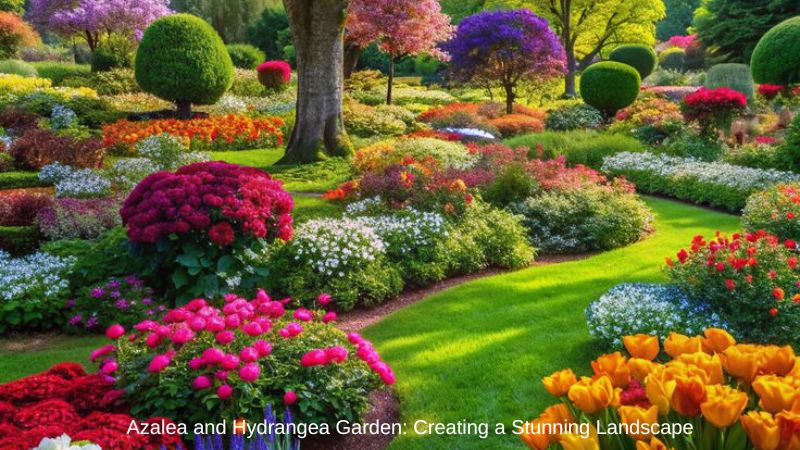Designing a garden with both azaleas and hydrangeas can create a vibrant, lush landscape bursting with color throughout the year. These two flowering plants complement each other beautifully, offering striking contrasts in color, size, and shape. An azalea and hydrangea garden not only showcases the beauty of these plants but also provides a harmonious balance between early spring blooms and summer splendor. This guide Garden 03 will explore the essentials of creating a thriving azalea and hydrangea garden, including plant selection, design tips, care, and maintenance.
Why Choose Azaleas and Hydrangeas?
1. Aesthetic Appeal
Azaleas and hydrangeas are two of the most popular flowering shrubs for ornamental gardens, known for their stunning blooms and versatility. Azaleas, with their vibrant and showy spring flowers, provide an early burst of color. They come in a variety of shades, including pink, red, white, and purple. Hydrangeas, on the other hand, offer large, globe-shaped flowers that bloom in the summer, ranging from blue to pink to white, depending on soil conditions. The combination of these two plants ensures a visually dynamic garden across multiple seasons.
2. Seasonal Color and Interest
One of the biggest advantages of an azalea and hydrangea garden is the extended period of flowering it offers. Azaleas typically bloom in early to late spring, while hydrangeas burst into bloom in the summer. This staggered flowering period means your garden will always have color and interest from spring through summer. With some hydrangea species, such as the panicle hydrangea, you can even enjoy flowers well into fall.
3. Contrasting Textures
Azaleas and hydrangeas also offer a unique contrast in textures. Azaleas tend to have smaller, more delicate blooms with finer leaves, while hydrangeas boast larger, bolder flowers and broad leaves. This contrast enhances the visual depth and complexity of your garden, creating a balanced and pleasing landscape.
Selecting the Right Azaleas and Hydrangeas
1. Types of Azaleas
When planning your azalea and hydrangea garden, it’s important to choose the right varieties that will thrive in your specific growing conditions. Azaleas come in two primary types: deciduous and evergreen.
- Evergreen Azaleas: These varieties retain their leaves year-round and bloom heavily in the spring. Popular choices include the Kurume azaleas, which have smaller, dense flowers, and the larger-flowered Southern Indian azaleas.
- Deciduous Azaleas: These shed their leaves in the fall but often have larger and more fragrant flowers. Deciduous azaleas like the Exbury or Northern Lights series offer bright, showy blooms that stand out in any garden.
2. Types of Hydrangeas
Hydrangeas come in several different species, each offering unique colors and bloom forms. Consider the following types for your garden:
- Bigleaf Hydrangea (Hydrangea macrophylla): This is the most common species, known for its large, round clusters of flowers. The color of the blooms can change based on soil pH—acidic soils produce blue flowers, while alkaline soils result in pink flowers.
- Panicle Hydrangea (Hydrangea paniculata): Panicle hydrangeas are known for their cone-shaped flower clusters and are more tolerant of sunlight. They typically bloom later in the summer and can extend your garden’s flowering season into fall.
- Smooth Hydrangea (Hydrangea arborescens): This species produces large white blooms, with the ‘Annabelle’ variety being especially popular for its giant, snowball-like flowers.
- Oakleaf Hydrangea (Hydrangea quercifolia): Named for its oak-shaped leaves, this hydrangea species adds texture and fall color to your garden. The blooms typically start out white and fade to pink or red as they age.
3. Complementing Bloom Times
When choosing azaleas and hydrangeas for your garden, it’s important to select varieties that will bloom at different times to ensure a continuous display of color. Look for early-blooming azaleas to pair with mid- or late-season hydrangeas. This will help you achieve a garden that evolves throughout the seasons, offering a vibrant mix of colors from spring to fall.
Designing Your Azalea and Hydrangea Garden

1. Creating a Balanced Layout
When designing your azalea and hydrangea garden, focus on creating a balanced and harmonious layout. Place azaleas in areas where they can serve as the spring focal point, such as the front of garden beds or along pathways. Hydrangeas, with their larger stature and summer blooms, should be planted in more prominent positions where their large flowers can stand out.
To create a layered effect, plant azaleas in the foreground and hydrangeas in the background. This works especially well in larger gardens, where you can create depth by staggering the heights and bloom times of the shrubs. In smaller spaces, consider dwarf varieties of azaleas and hydrangeas that won’t overwhelm the garden.
2. Ideal Growing Conditions
Both azaleas and hydrangeas thrive in similar growing conditions, making them perfect companions in the garden. They prefer well-drained, acidic soil with plenty of organic matter. Azaleas are especially sensitive to soil pH, so testing your soil and amending it as needed can help ensure healthy growth.
Both plants prefer partial shade to protect their delicate blooms from the intense midday sun. A spot with morning sun and afternoon shade is ideal. However, some hydrangea species, like panicle hydrangeas, can tolerate more sun, so be mindful of the specific needs of the varieties you choose.
3. Grouping and Spacing
Proper spacing is essential when planting azaleas and hydrangeas. Azaleas should be spaced about 3 to 4 feet apart, depending on the variety, while larger hydrangeas may require 4 to 6 feet of space between each plant. Grouping the shrubs in odd numbers, such as threes or fives, can create a more natural and visually appealing layout.
Consider planting in drifts or clusters, rather than in straight lines, to give your garden a more organic and flowing appearance. This mimics the way these shrubs might grow in nature and enhances the overall aesthetic of your garden.
Caring for Your Azalea and Hydrangea Garden
1. Watering
Both azaleas and hydrangeas require consistent watering, especially during their growing and blooming seasons. These plants thrive in moist, well-drained soil, so be sure to water deeply and regularly, particularly during dry spells. Mulching around the base of the plants can help retain moisture and regulate soil temperature.
Azaleas are shallow-rooted and can dry out quickly, so it’s important to keep the soil evenly moist. Hydrangeas, especially bigleaf varieties, may wilt in the heat of summer, so watering them early in the morning or in the evening can help prevent stress.
2. Pruning
Pruning is essential to maintain the shape and health of both azaleas and hydrangeas. Azaleas should be pruned right after they finish blooming in the spring. This allows them to set new buds for the following year. Remove any dead or damaged branches, and trim back overgrown areas to maintain a neat shape.
Hydrangeas, on the other hand, require different pruning methods depending on the species. Bigleaf and oakleaf hydrangeas bloom on old wood, so they should be pruned in late summer after blooming. Panicle and smooth hydrangeas bloom on new wood and can be pruned in late winter or early spring to encourage new growth.
3. Fertilizing
Azaleas and hydrangeas benefit from regular fertilization, especially during the growing season. Use a slow-release fertilizer formulated for acid-loving plants. For azaleas, apply fertilizer after they bloom in the spring to promote healthy foliage and root development. Hydrangeas can be fertilized in early spring and again after their first round of blooms.
To encourage blue blooms in bigleaf hydrangeas, you can add aluminum sulfate to the soil. For pink blooms, add lime to raise the soil pH. Always follow the manufacturer’s instructions when applying soil amendments or fertilizers to avoid overfeeding or damaging your plants.
Troubleshooting Common Issues
1. Pests and Diseases
Azaleas and hydrangeas are relatively low-maintenance, but they can occasionally suffer from pests and diseases. Azalea lace bugs and spider mites are common pests that can affect azaleas, causing yellow or spotted leaves. Insecticidal soap or neem oil can help control these pests.
Hydrangeas may be affected by powdery mildew, especially in humid conditions. Proper air circulation, watering at the base of the plant, and removing affected leaves can help prevent the spread of fungal diseases.
2. Bloom Failure
If your azaleas or hydrangeas are not blooming, it may be due to improper pruning, insufficient sunlight, or poor soil conditions. Make sure you are pruning at the correct time and providing adequate light for the species you have chosen. Testing the soil and amending it with the appropriate nutrients can also help improve flowering.
Conclusion
An azalea and hydrangea garden creates a vibrant, multi-season landscape with colorful blooms from spring through fall. By selecting the right varieties, ensuring proper soil conditions, and providing regular care like watering and pruning, you can cultivate a beautiful and tranquil space. Whether for a peaceful retreat or a splash of color, this garden style suits gardeners of all levels. With minimal effort, your garden can become a lush haven, admired for its natural beauty and serenity.





